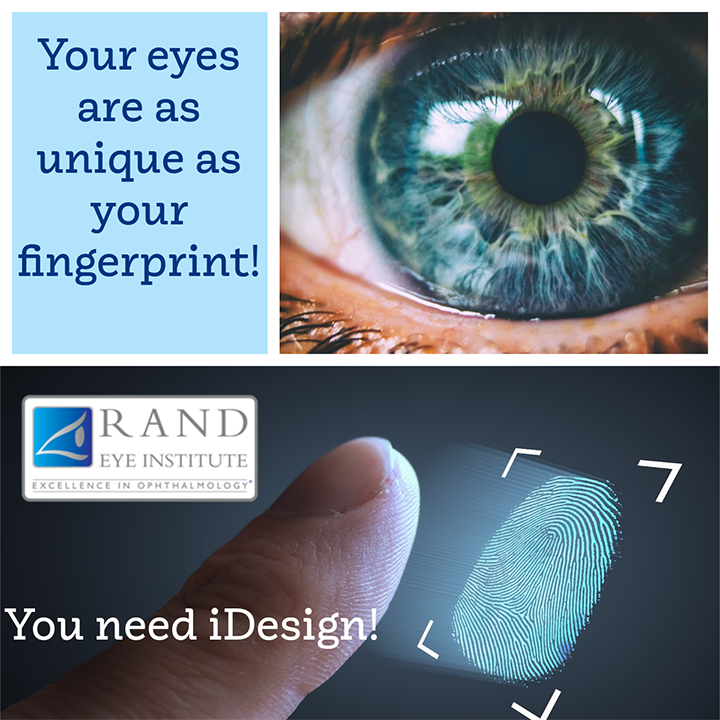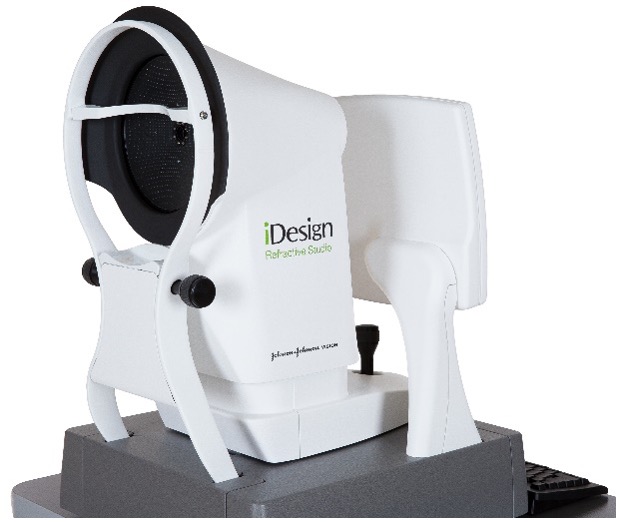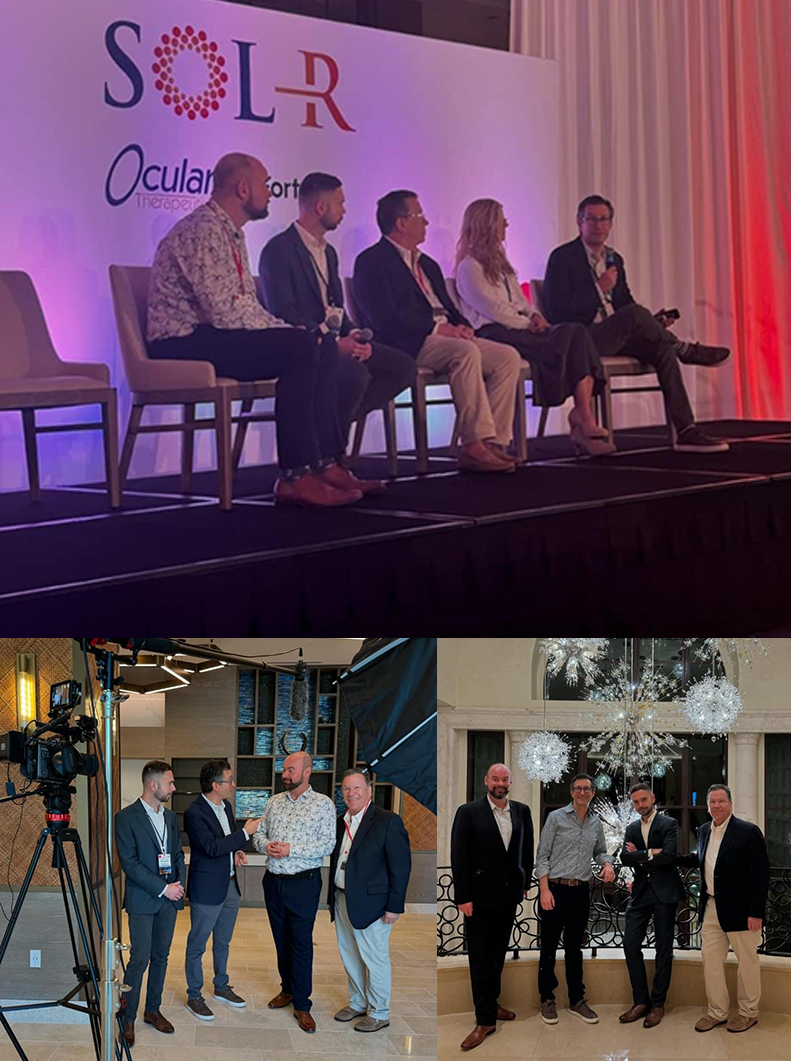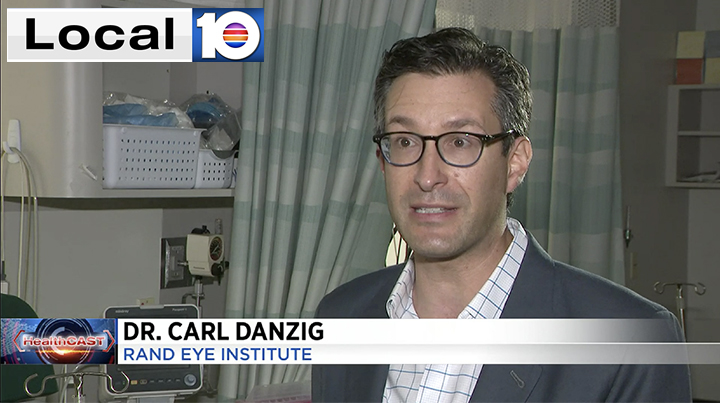SOL Shine Recognition Award
During our meeting in Orlando, our clinical trial department @randeyeinstitute Carl Danzig, MD and Damian Stega, received the SOL Shine Recognition Award as a center of excellence for the management of WET MACULAR DEGENERATION patients in the SOL-1 and SOL-R clinical trials. We are extremely proud of our clinical trial team and forever grateful for the trust our patients have bestowed upon us. Thank you @oculartherapeutix for this honor! hashtag#randeyeinstitute
Clinical Trials Study investigates gene therapy for vision condition
Rand Eye Institute Director of Vitreo-Retinal Services Dr. Carl Danzig is the first in South Florida to administer an investigational gene therapy for people with dry age-related macular degeneration, commonly known as AMD.
The clinical trial, called Horizon, involves a single, one-time injection under the retina at the back of the eye to deliver this gene therapy.
“This is different than wet macular degeneration, which people know about, that takes place in the office. This is in the operating room, where we enter the eyeball and we go under the retina with a very tiny needle and we inject some gene therapy, and what this does, it provides instructions for your own cells to produce a natural regulatory protein that you already have and basically upregulate that — you make that more and therefore, hopefully, fight the progression of this disease,” Danzig said.
Click the link below to watch the full interview as seen on Local 10 HealthCAST with Kristi Krueger.
https://www.local10.com/health/2022/02/17/study-investigates-gene-therapy-for-vision-condition/
What is iDesign Technology?

Laser Vision correction has come a long way since its inception. The parameters of corrections that can be treated today were just a dream a few years ago. A good correction has become an exact personalized treatment for each eye. At Rand Eye Institute, we are dedicated to being up to date with the latest FDA-approved technology. This is the reason why we utilize our Star S4 IR Excimer Laser System and iDesign 2.11 Advanced Wavescan Studio System – the finest technology in laser vision correction.Up until a few years ago, an ophthalmologist used your eyeglass prescription to determine your treatment. iDesign technology has revolutionized laser vision correction by providing a detailed map of the surface of the eye plus information on how well your cornea and lens refract light.

The iDesign system scans your cornea to provide information on the eye’s low order aberrations (myopia, hyperopia, and astigmatism), and high order aberrations (personal characteristics of an eye that cause halos, glare, and poor night vision). Consequently, the surgeon, now, has the full spectrum of refractive errors that need to be corrected to provide excellent visual outcomes. The iDesign system and technology are called wavefront integrated vision correction. This system collects 1,200 data points of your eye. Hence, making the treatment 25 times more accurate than just checking your vision and glass prescription.
The detailed iDesign map is then sent to the Star S4 IR Excimer Laser System. This detailed map provides all the information for the excimer laser to know where and how to sculpt the cornea for best visual outcomes. No two eyes are the same. Tiny personal characteristics in your cornea (like your fingerprint) create visual errors. These characteristics can only be measured with the iDesign system.
Our mission at Rand Eye Institute is to provide our patients with the best possible visual outcome. iDesign technology allows us to achieve an even higher degree of vision.
Love your vision for years to come! Call Rand Eye Institute at 954-782-1700 for your complimentary LASEK consultation.
May is Healthy Vision Month

What are the most important tips to maintaining a healthy vision? We asked our doctors and came up with a simple list that everybody can follow. Your eyes are the window to the world. You get only one set so please be kind to them, so they can take care of and protect you!
- An Annual Eye exam.
Many people believe that if you do not have any issues with your eyes, you do not need to have them checked. Your eye physician needs to know how your eyes are when you are healthy and then compare test results when an issue arises. In ophthalmology, if a condition is caught early, chances are best at treating it or stopping its progression. Many common eye diseases like glaucoma, diabetic eye disease, and macular degeneration often do not provide warning signs. No one can afford to be lazy with their eyes! - Eat a balanced diet.
Eating a balanced diet will keep you and your eyes healthy. Nutrients such as Omega-3 fatty acids, zinc, and Vitamin C provide extra nourishment and vision protection. A diet rich in fruits and vegetables, particularly dark leafy greens such as spinach, kale, or collard greens, as well as foods rich in Omega-3 fatty acids like salmon, tuna, eggs, and nuts are important to maintaining a healthy vision. - Do not Smoke!
Smoking is as bad for your eyes as it is for your lungs and the rest of your body. Studies have linked smoking with the development of age-related macular degeneration and optic nerve damage. - Exercise
When a person exercises, the circulation improves in the body and thus the toxins are released. For the entire body to be healthy, a person needs good circulation. Make your exercise fun. Find an activity that makes you smile! Enjoy it! - Wear Sunglasses.
We are lucky to live in sunny Florida. We love sunny skies and the beautiful weather. However, please do not forget to protect your eyes! Choose sunglasses that block 90% of both UVA and UVB rays. For long walks, wear a hat to provide extra protection. - Wear Protective Eyewear.
Wear protective eyewear when playing sports, working on your hobby, gardening, etc. Also, remember to wear protection at work if it’s deemed necessary to your profession. - Get informed about your family’s eye health history.
Ask your relatives about their eye conditions if any. Some conditions are hereditary. This information will help determine if you are at a higher risk for the development of an eye disease or condition. Remember most eye conditions, if caught early, can be treated or slow down their progression. - Give your eyes a rest.
Try the 20-20-20 rule! Every 20 minutes look away about 20 feet in front of you for 20 seconds. This exercise helps with eye strain.
These tips are not hard to follow. One just needs to make a conscious effort to be kind to their eyes. If you have any questions, please call your eye physician for more detailed information. Rand Eye Institute is just a call away if you need assistance our ophthalmologists are on-call 24/7. Your eyes are important to us!
KEEP an ‘EYE’ on Hurricane Related Injuries
For Immediate Release: May 30, 2014
Rand Eye Institute offers Hurricane Eye Safety Tips in an Effort to Reduce and Prevent Pre- and Post- Storm Eye Injuries
Deerfield Beach, Fla. — In response to the rising number of hurricane related injuries over the past hurricane seasons, the Rand Eye Institute, a comprehensive eye care and surgical facility in Deerfield Beach, is assisting South Florida residents anticipate and prepare for an increasing number of storm related eye injuries. Rand Eye Institute’s “Hurricane Eye Safety Tips” can be found at: randeye.com
While a number of injuries are directly caused by the storm’s landfall and deteriorating weather conditions, the majority of reported incidents are caused indirectly, occurring as a result of pre- and post-storm preparation and recovery efforts. Of these, 90 percent are avoidable. By taking steps laid out by Rand Eye Institute, before, during and after a storm, many of these potential hazards can be reduced and potentially prevented.
“Eye injuries have increased in past storms. Anticipating and preparing for risks that can potentially lead to an eye injury should be part of any emergency disaster plan,” says William J. Rand, MD chief surgeon and medical director of the Rand Eye Institute.
Because flying fragments of metal, wood, concrete and other building materials, along with windblown dust and debris account for the highest number of eye injuries, one of the simplest ways to prevent eye injuries is to wear protective eye goggles or safety glasses, which should be included with other hurricane supplies. Wearing protective eyewear, even when putting up shutters, removing debris or working with both hand and power tools, can reduce the risk of injuring the eye.
The Rand Eye Institute also recommends:
- Avoid rubbing or touching irritated areas of the eye – especially if you suspect the presence of debris particles or chemical solutions. Wash and rinse with clean, preferably bottled water.
- Having essential medications, including preservative-free eye drops on hand
- Sterilizing contact lenses more frequently – especially when dealing with unsanitary conditions
- Current prescription eye glasses and copy of original prescription
- Preparing a list of all physician emergency contact numbers, including your ophthalmologist and/or optometrist
- Seeking immediate medical attention if you experience a serious eye injury or problem.
Call 954-782-1700 or toll-free 1-800-782-1711
With a compliment of Board Certified Ophthalmologists, who are on call to address your most immediate concerns, the Rand Eye Institute, an emergency generator-powered facility, provides 24-hour emergency care, with an on-site, fully licensed and Joint Commission accredited ambulatory and surgical center, capable of treating a full-range of eye injuries.
Specializing in refractive surgeries such as custom no-flap laser vision correction, lens exchange procedures, custom laser cataract surgery, vitreo-retinal surgery and corneal transplantation; the Rand Eye Institute is a comprehensive eye care and surgical facility, which offers a full-range of patient services, including routine eye examinations, treatment for dry eye syndrome, advanced testing and sophisticated ophthalmic treatments for various eye conditions. The Rand Eye Institute’s compliment of qualified, Board certified doctors and professional staff provide patients with quality and compassionate care.
Located on the first floor is the Rand Surgical Pavillion, a state-of-the-art fully licensed and Joint Commission accredited surgical facility, which offers the highest level of surgical care, surpassing nationally accepted standards for safety, sterility, technology, and quality outcomes.
Founded in 1979 by William J. Rand, M.D., one of the most experienced eye surgeons in the country, the Rand Eye Institute is centrally located in Southeast Florida at 5 West Sample Road in Deerfield Beach, FL 33064. For more information about the Rand Eye Institute, please visit www.randeye.com or call 1-800-782-1711.



